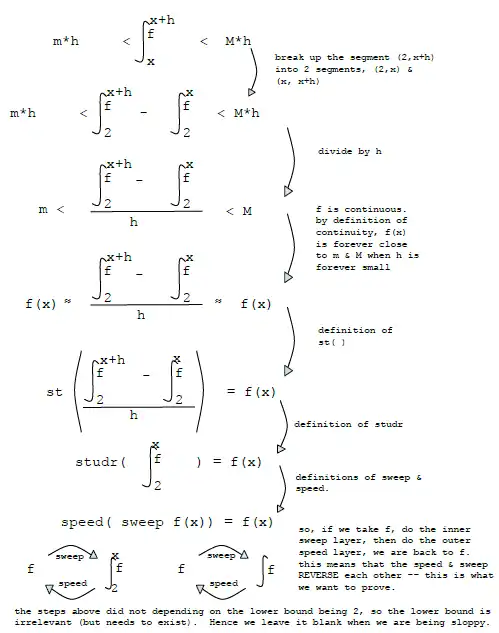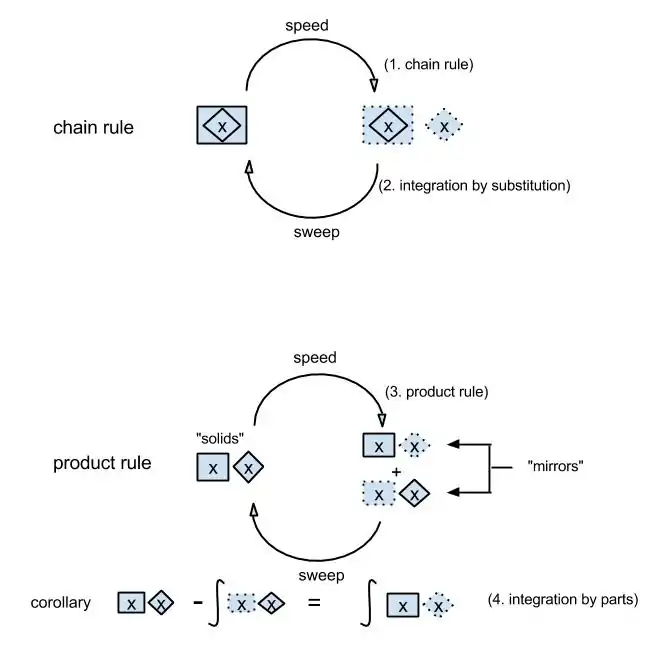sweep is the term used for definite integrals. The term comes from Riemann Sums where a function f(x) sweeps out the area under it.
It helps to give the student an overview of what's to come. Review the table below with them. The Diagram column explicitly shows the Fundamental Theorem symmetry. In the power & product rule, that symmetry is not clear from the formulas in the Sweep & Speed columns.
| rule | diagram | sweep | speed |
|---|---|---|---|
| constant | c <--> 0 | sweep(0) = c | c' = 0 |
| variable | x <--> 1 | sweep(1) = x | x' = 1 |
| power ** |
N n ( x <--> Nx ) / N |
sweep(x^n) = x^(n+1) / n+1 | (x^n)' = n*x^(n-1) |
| leak | cf <--> cf' | sweep(c*f) = c*sweep(f) | (c*f)' = c*f' |
| sum | f+g <--> f' + g' | sweep(f+g) = sweep(f) + sweep(g) | (f+g)' = f' + g' |
| product | fg <--> sum of mirrors | see below | (fg)' = f' + g' |
| chain | f(g) <--> f'(g) * g' | sweep( f'(g)*g' ) = f(g) | (f(g)' = f'(g) * g' |
| quotient | -- | -- | -- |
Notation:
- c=constant,
- f=f(x), g=g(x),
- we leave out "+C" in integrals,
- N = n+1,
- <--> = arrow right for speed, arrow left for sweep
- ** in the power rule, divide the diagram by N to get an explicit diagram for sweep(x^n): x^N / N <--> x^n
Fundamental Theorem of Calculus
Proof:

Chain & Product Rules
Too many speed & sweep identities can lead to confusion. Writing the speed & sweep rule in a single diagram style offers clarity. The 4 rules below in shape notation are of the form
-----> where "--->" is the speed operator, that is speed(a) = (b)
(a) (b)
<----- and "<----" is the sweep operator, sweep(b) = (a)

From the diagram, we can read off the anti-chain rule (integration by substitution) and anti-product rule (integration by parts). To succinctly verbalize the anti-product formula, we introduce the term "mirror". The mirror of a product f * g' is f' * g. Now the anti-product formula in the picture above is read as "solids minus sweep-of-mirror".
For most exercises, anti-chain is easier than anti-product. To determine the correct solution path, anti-chain only requires that the student identifies the existence of a composition-of-functions.
Integration-by-parts is trickier for beginners since a student can perform long calculations only to find out he/she tried the wrong path. The student needs to first determine which factor can be eroded by successive speeds (called speed erosion). The algorithm for integral(A*B) is:
- "line it": decide which factor is to be the dash & which is the solid.
- make sure this choice simplifies the mirror. If the mirror does not simplify, switch lines. Usually, simplification means an exponent was reduced in the mirror.
- list the 4 possible lined-shapes & their formulas: solid-A, dash-A, solid-B, dash-B
- plug into the formula
It's important to de-emphasize the formula & just remember that it's "solids - sweep(mirror)", rather than solid-A * solid-B - sweep( dash-A * solid-B ). This way, the student does not get confused when the student has to switch the dash/solid line assignment if step #2 needs to be re-done.
In summary
- if there are nested functions, then try anti-chain.
- if there is speed erosion, then try anti-product.
Exercises
Aside from the typical computational exercises, students should be able to prove the Fundamental Theorem of Calculus. As in the Chain Rule, this should be done almost to the point of memorization to drive home the idea of proofs.